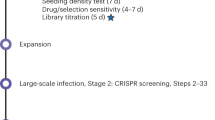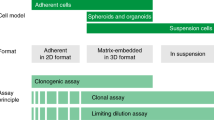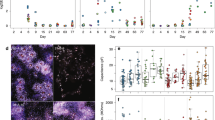Abstract
For more than a decade the 'neurosphere assay' has been used to define and measure neural stem cell (NSC) behavior, with similar assays now used in other organ systems and in cancer. We asked whether neurospheres are clonal structures whose diameter, number and composition accurately reflect the proliferation, self-renewal and multipotency of a single founding NSC. Using time-lapse video microscopy, coculture experiments with genetically labeled cells, and analysis of the volume of spheres, we observed that neurospheres are highly motile structures prone to fuse even under ostensibly 'clonal' culture conditions. Chimeric neurospheres were prevalent independent of ages, species and neural structures. Thus, the intrinsic dynamic of neurospheres, as conventionally assayed, introduces confounders. More accurate conditions (for example, plating a single cell per miniwell) will be crucial for assessing clonality, number and fate of stem cells. These cautions probably have implications for the use of 'cytospheres' as an assay in other organ systems and with other cell types, both normal and neoplastic.
This is a preview of subscription content, access via your institution
Access options
Subscribe to this journal
Receive 12 print issues and online access
$259.00 per year
only $21.58 per issue
Buy this article
- Purchase on Springer Link
- Instant access to full article PDF
Prices may be subject to local taxes which are calculated during checkout




Similar content being viewed by others
References
Reynolds, B.A. & Weiss, S. Generation of neurons and astrocytes from isolated cells of the adult mammalian central nervous system. Science 255, 1707–1710 (1992).
Reynolds, B.A., Tetzlaff, W. & Weiss, S. A multipotent EGF-responsive striatal embryonic progenitor cell produces neurons and astrocytes. J. Neurosci. 12, 4565–4574 (1992).
Reynolds, B.A. & Weiss, S. Clonal and population analyses demonstrate that an EGF-responsive mammalian embryonic CNS precursor is a stem cell. Dev. Biol. 175, 1–13 (1996).
Craig, C.G. et al. In vivo growth factor expansion of endogenous subependymal neural precursor cell populations in the adult mouse brain. J. Neurosci. 16, 2649–2658 (1996).
Represa, A., Shimazaki, T., Simmonds, M. & Weiss, S. EGF-responsive neural stem cells are a transient population in the developing mouse spinal cord. Eur. J. Neurosci. 14, 452–462 (2001).
Chojnacki, A. & Weiss, S. Isolation of a novel platelet-derived growth factor-responsive precursor from the embryonic ventral forebrain. J. Neurosci. 24, 10888–10899 (2004).
Tropepe, V. et al. Distinct neural stem cells proliferate in response to EGF and FGF in the developing mouse telencephalon. Dev. Biol. 208, 166–188 (1999).
Tropepe, V. et al. Retinal stem cells in the adult mammalian eye. Science 287, 2032–2036 (2000).
Seaberg, R.M. & van der Kooy, D. Adult neurogenic regions: the ventricular subependyma contains neural stem cells, but the dentate gyrus contains restricted progenitors. J. Neurosci. 22, 1784–1793 (2002).
Ramirez-Castillejo, C. et al. Pigment epithelium-derived factor is a niche signal for neural stem cell renewal. Nat. Neurosci. 9, 331–339 (2006).
Hitoshi, S. et al. Primitive neural stem cells from the mammalian epiblast differentiate to definitive neural stem cells under the control of Notch signalling. Genes Dev. 18, 1806–1811 (2004).
Kippin, T.E., Martens, D.J. & van der Kooy, D. p21 loss compromises the relative quiescence of forebrain stem cell proliferation leading to exhaustion of their proliferation capacity. Genes Dev. 19, 756–767 (2005).
Kippin, T.E., Kapur, S. & van der Kooy, D. Dopamine specifically inhibits forebrain neural stem cell proliferation, suggesting a novel effect of antipsychotic drugs. J. Neurosci. 25, 5815–5823 (2005).
Kukekov, V.G., Laywell, E.D., Thomas, L.B. & Steindler, D.A. A nestin-negativ precursor cell from the adult mouse brain gives rise to neurons and glia. Glia 21, 399–407 (1997).
Suslov, O.N., Kukekov, V.G., Ignatova, T.N. & Steindler, D.A. Neural stem cell heterogeneity demonstrated by molecular phenotyping of clonal neurospheres. Proc. Natl. Acad. Sci. USA 99, 14506–14511 (2002).
Imura, T., Kornblum, H.I. & Sofroniew, M.V. The predominant neural stem cell isolated from postnatal and adult forebrain but not early embryonic forebrain expresses GFAP. J. Neurosci. 23, 2824–2832 (2003).
Kim, M. & Morshead, C.M. Distinct populations of forebrain neural stem and progenitor cells can be isolated using side-population analysis. J. Neurosci. 23, 10703–10709 (2003).
Morshead, C.M., Garcia, A.D., Sofroniew, M.V. & van der Kooy, D. The ablation of glial fibrillary acidic protein-positive cells from the adult central nervous system results in the loss of forebrain neural stem cells but not retinal stem cells. Eur. J. Neurosci. 18, 76–84 (2003).
Molofsky, A.V. et al. Bmi-1 dependence distinguishes neural stem cell self-renewal from progenitor proliferation. Nature 425, 962–967 (2003).
Nunes, M.C. et al. Identification and isolation of multipotential neural progenitor cells from the subcortical white matter of the adult human brain. Nat. Med. 9, 439–447 (2003).
Zhang, S.C., Lipsitz, D. & Duncan, I.D. Self-renewing canine oligodendroglial progenitor expanded as oligospheres. J. Neurosci. Res. 54, 181–190 (1998).
Seaberg, R.M. et al. Clonal identification of multipotent precursors from adult mouse pancreas that generate neural and pancreatic lineages. Nat. Biotechnol. 22, 1115–1124 (2004).
Toma, J.G. et al. Isolation of multipotent adult stem cells from the dermis of mammalian skin. Nat. Cell Biol. 3, 778–784 (2001).
Matsuda, M. et al. Serotonin regulates mammary gland development via an autocrine-paracrine loop. Dev. Cell 6, 193–203 (2004).
Hemmati, H.D. et al. Cancerous stem cells can arise from pediatric brain tumors. Proc. Natl. Acad. Sci. USA 100, 15178–15183 (2003).
Snyder, E.Y. et al. Multipotent neural cell lines can engraft and participate in development of mouse cerebellum. Cell 68, 33–51 (1992).
Parker, M.A. et al. Expression profile of an operationally-defined neural stem cell clone. Exp. Neurol. 194, 320–332 (2005).
Gritti, A. et al. Multipotent neural stem cells reside into the rostral extension and olfactory bulb of adult rodents. J. Neurosci. 22, 437–445 (2002).
Lobo, M.V. et al. Cellular characterization of epidermal growth factor-expanded free-floating neurospheres. J. Histochem. Cytochem. 51, 89–103 (2003).
Morshead, C.M., Benveniste, P., Iscove, N.N. & van der Kooy, D. Hematopoietic competence is a rare property of neural stem cells that may depend on genetic and epigenetic alterations. Nat. Med. 8, 268–273 (2002).
Wilson, H.V. On some phenomena of coalescence and regeneration in sponges. J. Exp. Zool. 5, 245–258 (1907).
Studer, L., Tabar, V. & McKay, R.D.G. Transplantation of expanded mesencephalic precursors leads to recovery in parkinsonian rats. Nat. Neurosci. 1, 290–295 (1998).
Garcia, A.D., Doan, N.B., Imura, T., Bush, T.G. & Sofroniew, M.V. GFAP-expressing progenitors are the principal source of constitutive neurogenesis in adult mouse forebrain. Nat. Neurosci. 7, 1233–1241 (2004).
Reynolds, B.A. & Rietze, R.L. Neural stem cells and neurospheres – re-evaluating the relationship. Nat. Methods 2, 333–336 (2005).
Gritti, A. et al. Epidermal and fibroblast growth factors behave as mitogenic regulators for a single multipotent stem cell-like population from the subventricular region of the adult mouse forebrain. J. Neurosci. 19, 3287–3297 (1999).
Acknowledgements
We acknowledge the contributions of M. Ditter, C.E. Hagemeyer, A. Papazoglou, A. Klein and A. Fahrner. We thank W. Wünsch for his help digitizing the videos. We also thank J. Loring for technical help with Supplementary Video 6 and A. Eroshkin for discussion on the mathematical model in the Supplementary Note. This work was supported by the Deutsche Forschungsgemeinschaft (Si874/2-1), the US National Institutes of Health, the American Parkinson's Disease Association, Children's Neurobiological Solutions, the March of Dimes, Margot Anderson Brain Restoration Foundation and Project ALS.
Author information
Authors and Affiliations
Corresponding authors
Ethics declarations
Competing interests
The authors declare no competing financial interests.
Supplementary information
Supplementary Fig. 1
Beating cellular specializations of neurosphere cells. (PDF 102 kb)
Supplementary Note
Mathematical analysis of proliferative cells in secondary neurospheres. (PDF 131 kb)
Supplementary Video 1
Representative time-lapse video microscopy demonstrating frequent, rapid, and multiple “coalescence” of secondary neurospheres. Note that neurospheres are capable of active locomotion, apparently propelled by tiny beating cellular processes. The movie shows a ∼2.5 hr segment of the 10-hr time-lapse recording excerpted as well in Fig. 2. The video recorder captured images every 3.5 seconds. This neurosphere culture was generated from the dissociated forebrain of a newborn mouse, initially seeded at a density of 50 cells/μl and 104 cells/cm2 (standard “medium density”), and cultured for 5 days in a humidified atmosphere at 37°C and 5% CO2 at the time of this videomicrograph. For illustrative purposes, this movie presents an “overview” of a “medium” cell density culture in a 6-well plate. Numerous time-lapse video-microscopic recordings confirmed merging of spheres grown at even “clonal” cell density (Supplementary Video 2 online). The beating cellular processes are better appreciated at higher power in Supplementary Video 3 online. (MOV 1971 kb)
Supplementary Video 2
Time-lapse video-microscopy demonstrating, at higher magnification, neurosphere locomotion and “coalescence” despite plating at “clonal” density. Cellular processes (see also Supplemental Fig. 1 and Supplemental Video 3) propel neurospheres over considerable distances increasing the probability of coalescence events in even low density cultures. The movie shows a time-lapse recording of ∼2 hr. This neurosphere culture (24-well plate) was generated from the dissociated forebrain of a newborn mouse, initially seeded at a density of only 5 cells/μl and 103 cells/cm2 (“clonal” density), and cultured for 5 days in a humidified atmosphere at 37°C and 5% CO2 at the time of this videomicrograph. (MOV 676 kb)
Supplementary Video 3
Time-lapse video microscopy of human fetal cortex-derived neurospheres at higher magnification. Note the tiny beating cellular processes covering the surface of two merging human neurospheres. These beating structures were abundant on human and rodent neurospheres irrespective of their origin (e.g. cortex, striatum, spinal cord) and seem to propel them in suspension culture. (MOV 9235 kb)
Supplementary Video 4
Time-lapse video microscopy of human neurospheres grown in 96-well plates. Neurospheres are motile and merge in 96-well plates similar to the findings obtained in 6-well (Video 1) and 24-well (Video 2) plates. In this experiment with 96-well plates, the initial plating density was 10 cells/μl or 2000 cells/well (personal communication, B. Reynolds), but nevertheless still generated polyclonal spheres. Note that movie speed here is 5 times faster than in the other Videos. (MOV 6887 kb)
Supplementary Video 5
Time-lapse video microscopy of mouse cell culture showing neurosphere fusion and interaction of motile spheres with single cells attached to uncoated plastic dish. This example shows, besides the merging of two neurospheres, that single cells can attach to or detach from a motile neurosphere compromising their clonal boundaries even at “clonal” plating density (5 cells/μl). (MOV 2174 kb)
Supplementary Video 6
Time-lapse video microscopy of neurosphere-like cells that have become adherent. Note that adherent spheres, too, migrate and coalesce. Only if this concentrated culture dish had begun as a single isolated cell in a single isolated miniwell would an assumption of clonal boundaries and identity be justified and legitimate. In this experiment mouse forebrain stem cells (20 cells/μl) were plated into 24-well plates with glass coverslips coated with poly-L-lysine and laminin. The videomicrograph was taken on day 7. (MOV 5136 kb)
Rights and permissions
About this article
Cite this article
Singec, I., Knoth, R., Meyer, R. et al. Defining the actual sensitivity and specificity of the neurosphere assay in stem cell biology. Nat Methods 3, 801–806 (2006). https://doi.org/10.1038/nmeth926
Received:
Accepted:
Published:
Issue Date:
DOI: https://doi.org/10.1038/nmeth926
This article is cited by
-
Organization of self-advantageous niche by neural stem/progenitor cells during development via autocrine VEGF-A under hypoxia
Inflammation and Regeneration (2023)
-
Enteric neurospheres retain the capacity to assemble neural networks with motile and metamorphic gliocytes and ganglia
Stem Cell Research & Therapy (2023)
-
Efficient and safe single-cell cloning of human pluripotent stem cells using the CEPT cocktail
Nature Protocols (2023)
-
Folic acid depletion as well as oversupplementation helps in the progression of hepatocarcinogenesis in HepG2 cells
Scientific Reports (2022)
-
Current biomarker-associated procedures of cancer modeling-a reference in the context of IDH1 mutant glioma
Cell Death & Disease (2020)



